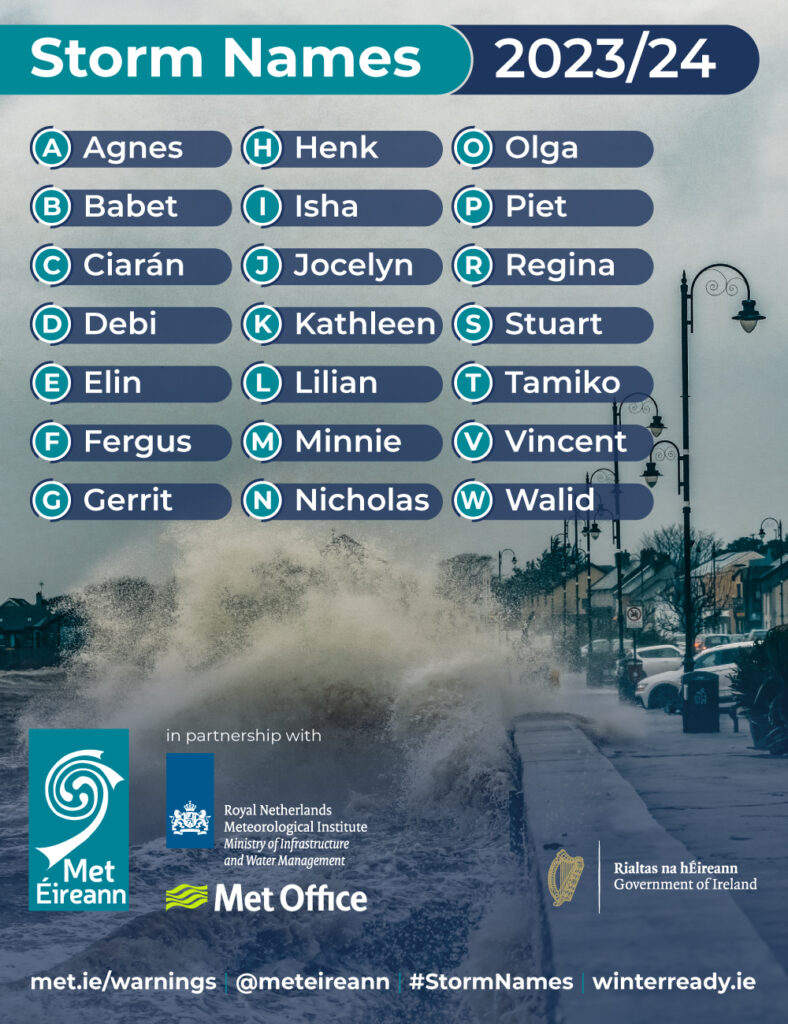NEW storm names for the season ahead pay homage to Irish scientists it was revealed today.
Met Éireann released the storm names that have been chosen for the 2023/24 season this morning.
The full list of 21 names have been selected in conjunction the Met Office in the UK and KNMI, the national weather service of the Netherlands.
Each of the three meteorological services contributed seven names to this season’s list, with Met Éireann opting for the names of scientists from across the island of Ireland, to “honour their important contributions to science and benefits for humankind”.
The full list of names for 2023/4 is Agnes, Babet, Ciarán, Debi, Elin, Fergus, Gerrit, Henk, Isha, Jocelyn, Kathleen, Lilian, Minnie, Nicholas, Olga, Piet, Regina, Stuart, Tamiko, Vincent and Walid.
The letters Q, U, X, Y, Z are not included in storm naming, in line with the US National Hurricane Centre naming convention.
The names chosen this year by Met Éireann are Agnes, Fergus, Jocelyn, Kathleen, Lillian, Nicholas and Vincent.
They honour Irish astronomer and science writer Agnes Mary Clerke and scientist Fergus O’Rourke, who contributed to myrmecology and medical entomology.
Jocelyn Bell is the Northern Irish astrophysicist who discovered the first pulsating radio stars in 1967.
Reacting to her inclusion in the new storm names list, Professor Bell Burnell said: “I am delighted to feature in this distinguished list celebrating science and hope that if a potential “Storm Jocelyn” happens, it may be a useful stirring-up rather than a destructive event.
"Science advancements increase our knowledge and understanding of the world around us, and I think this is wonderful example of science-based services communications.”
Kathleen honours Kathleen ‘Kay’ McNulty Mauchly Antonell, one of the mothers of computer programming, and Kathleen Lonsdale, the Irish crystallographer who demonstrated the crystal structure of benzene.
Lilian Bland was an Anglo-Irish journalist and pioneer aviator, who was the first woman in Ireland to build and fly an aircraft, named the Bland Mayfly.
Nicholas Callan was the physicist who invented the induction coil that was used in early telegraphy and is still being used in some electronic devices today and Vincent Barry is the scientist best known for leading the team which developed the anti-leprosy drug clofazimine.
Commenting on the names for 2023/4, Eoin Sherlock, Head of Forecasting Division in Met Éireann, said: “Storm naming is an important asset in our warnings arsenal and makes severe weather communications clearer and more effective.
“It connects our weather services more closely to the public, helping us in our mission to protect lives and property and ensuring the safety of our communities.”
He added: “We are delighted to celebrate science and scientists in this year’s names.
“As part of our process we asked the public to choose the name for letter “A”, resulting in Agnes, after Irish astronomer and science writer Agnes Mary Clerke.
“Our warmest thanks to all who voted and to those who suggested other names that we will keep in mind for future seasons.
“As we move in to storm season, we advise people to prepare now for possible severe weather events.”
Since 2015, Met Éireann and the UK Met Office have been working together on the naming programme.
They were joined by the Netherlands’ KMNI in 2019.
UK Met Office Head of Situational Awareness Will Lang said: “This is the ninth year of us naming storms and we do it because it works.
“Naming storms helps to ease communication of severe weather and provides clarity when people could be impacted by the weather.
“This year, it’s great to be able to recognise the collaborative efforts of some of our partners across the UK with the inclusion of names from some UK partner organisations. Working across different agencies allows us to help as many people as possible be prepared for severe weather.”

